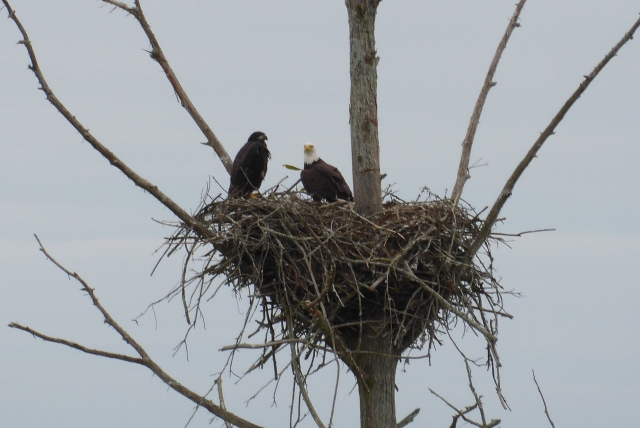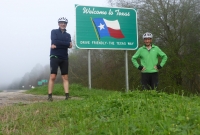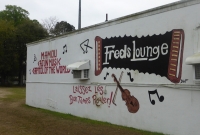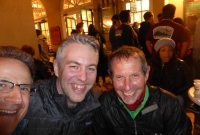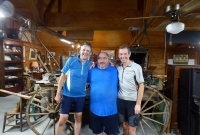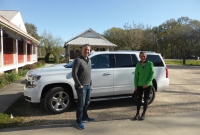The owner of the Maxey Care RV camp had told us there were no diners in Morganza. He’d obviously never spoken to his next door neighbour, or in fact visited any of the eateries alongside the railway line that runs through town. Perhaps if he’d spent more time putting up posters of the nearby amenties rather than the local sex offenders we’d have enjoyed a decent breakfast.
By the time we found out it was too late – we’d already dined on the delights of porridge oats, warmed up in the shower block microwave. Not that the porridge was a bad thing. We needed an inner glow as it was very cold today. We set off in four layers and kept them on for most of the day.
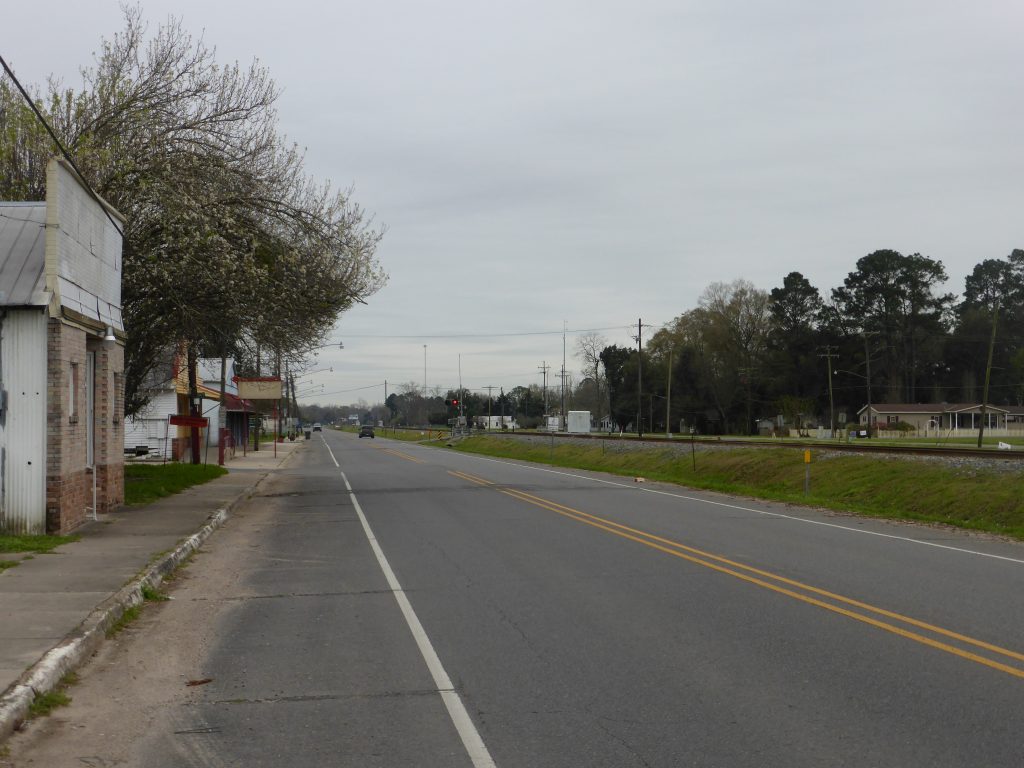
At the local store Bear, a bearded friendly chap with a passion for history, gave us the quick potted story of the town. Morganza, which now has around 600 residents, was once home to massive sugar cane plantations – indeed the village, as its now classified, takes its name from the Morganza Plantation, held before the Civil War by Charles Morgan, an early surveyor.
With the plantations came the railway line and of course slaves. It’s estimated that in the mid 1800s the highest concentration of millionaires in the U.S. could be found in one corridor, the Great River Road, which ran for about 120 miles long along the Mississippi River from New Orleans to the area around Baton Rouge.
“We could easily have ridden straight past the footprint of Melacon’s Cafe where a scene in the 1969 film ‘Easy Rider’ was shot”.
According to Bear even until even quite recently Morganza boasted several diners, shops and gas stations as the sugar industry was labour intensive and employed a large number of workers. But as artificial sweeteners have become more popular, the sugar industry has declined, taking it’s toll on main street. With so many people moving out of town it was yet another rural U.S. community doing all it could to attract new visitors.
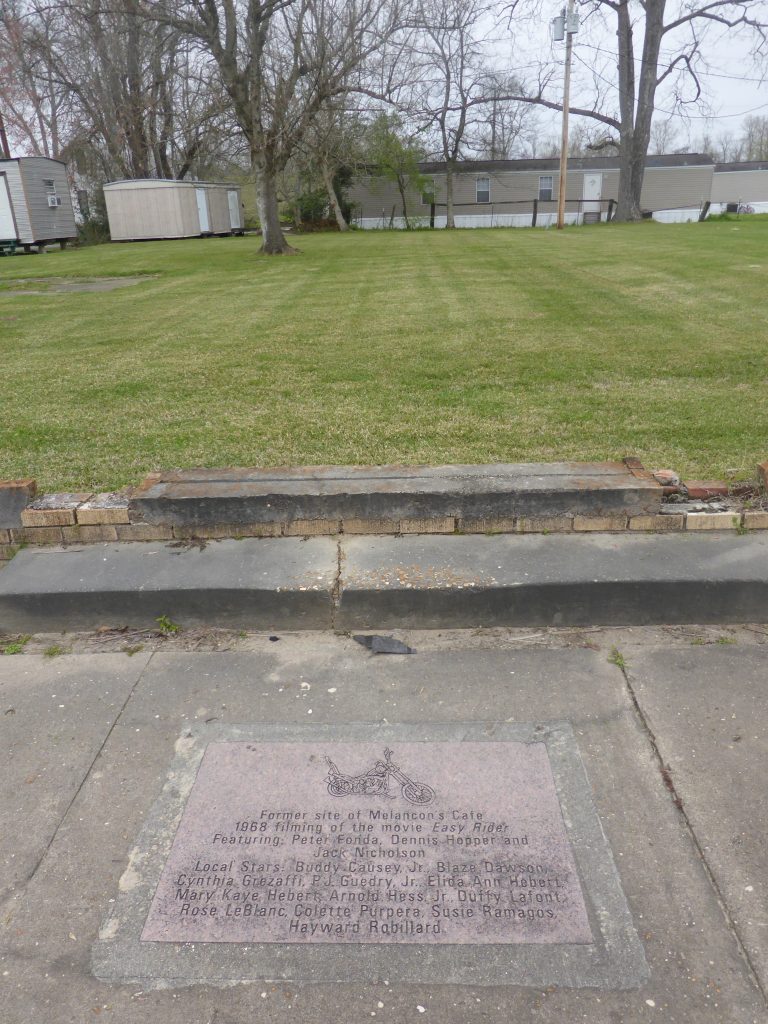
But Morganza still had a few tricks up its sleeve – not least the site of one of the cafes which had disappeared. Had Bear not pointed it out we could easily have ridden straight past the footprint of the Melacon’s Cafe where the cafe scene in the 1969 film ‘Easy Rider’ was shot. On a plaque beside a bare patch of grass were the names of Peter Fonda, Dennis Hopper and Jack Nicholson, as well as many of the locals who had featured in the scene. With the movie celebrating its 50th anniversary this year Bear was hoping for a big influx of visitors – and their motorbikes.
“It seems strange so few places have taken the Southern Tier route to their hearts in the way the TransAm communities have”.
Bear also told us a civil war fort had once stood here on the banks of the Mississippi – and that artefacts were still being found. He also said the town was the birthplace if the famous Blues player, Buddy Guy. “You’re on the Blues Highway here,” Bear explained. “There’s a lot of history here’,” he added, expanding on his plans to see a museum built in the town. Bear could clearly see the advantage of cyclists passing through Morganza – it seems strange so few places have taken the Southern Tier route to their hearts in the way the TransAm communities have.
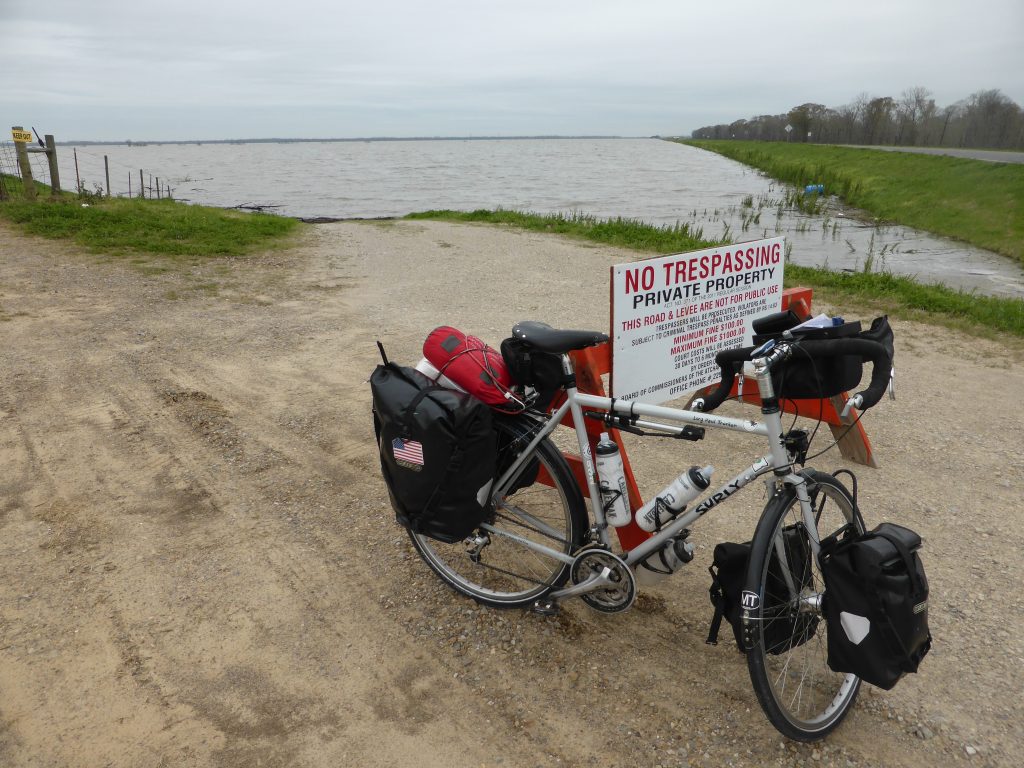
Talk inevitably turned to the river and the levees that are omnipresent. While providing safety they are also a constant reminder that just feet away from people’s homes are millions of gallons of water looking for a place to go. “There is so much water that both sides of the levee are seeping,” he said, explaining that the trains, which run along on top of the levee, often have to run slow to avoid rumbling it pieces. At times the trains are stopped altogether.
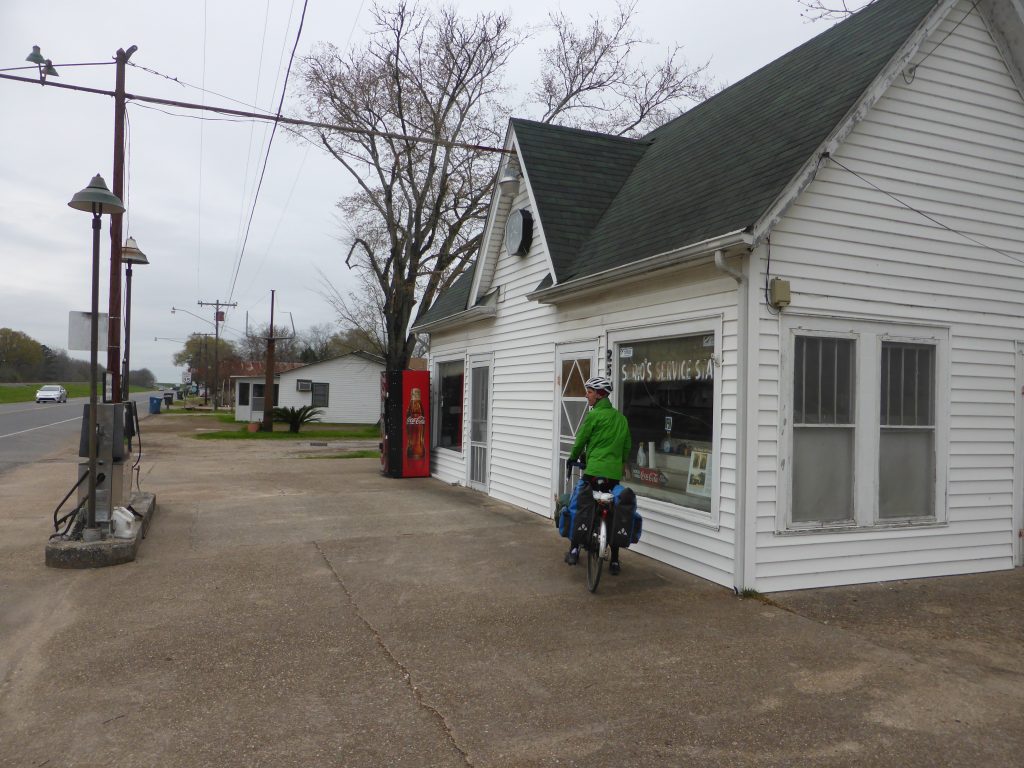
Not looking anywhere near as cool as Dennis Hopper or Peter Fonda, Terry and I saddled up and made to ride out of town, but Morganza kept holding us back. It may have seen its heyday a long time ago but it seemed Bear and others were doing all they could to celebrate local history with informative notice boards outside some of the older buildings, such as the gas station.
Today Morganza is better known for the Morganza Spillway, a massive flood control structure completed in 1954 to divert water during major floods from the Mississippi to the Atchafalaya Basin, therefore protecting Baton Rouge and New Orleans further downstream.
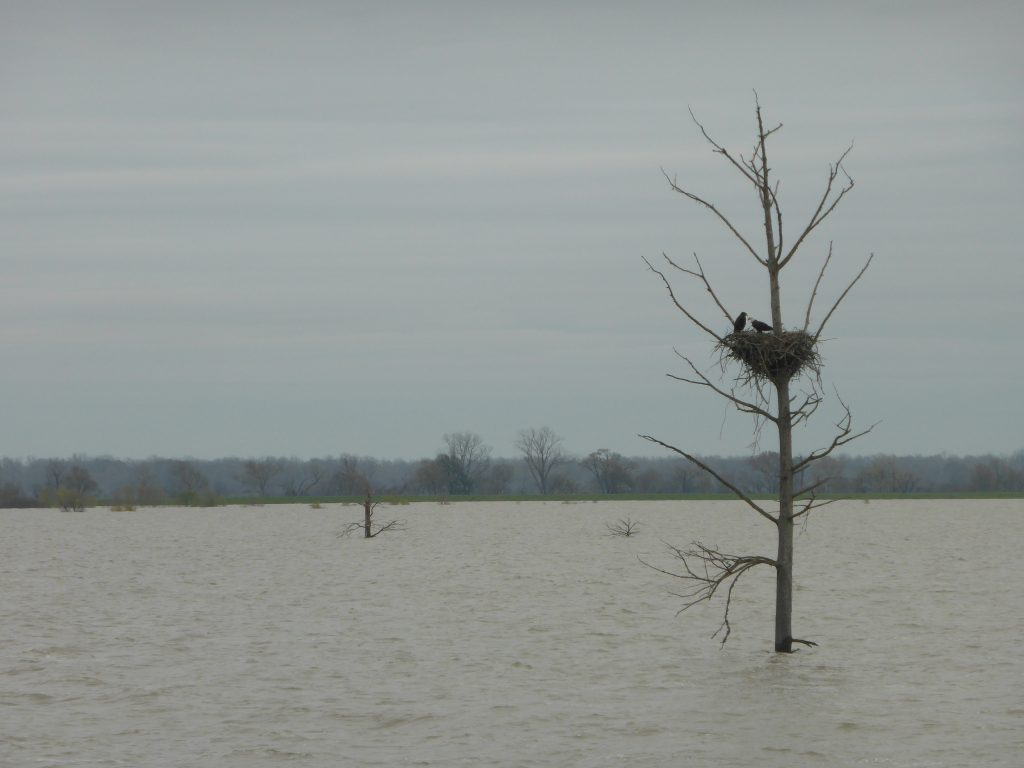
It’s an incredible feat of engineering, but as we rode across the levee and towards the spillway itself our eyes were on the lookout for a pair of American Bald Eagles which Bear had told us were nesting in the area. Four and a half miles out of town and the nest was exactly where he said it was. There, balanced in the branches of a tree standing almost alone in the floodwaters, was the unmistakable sight of not one, but two of the majestic birds – one a dark coloured juvenile which was almost as large as its parents.
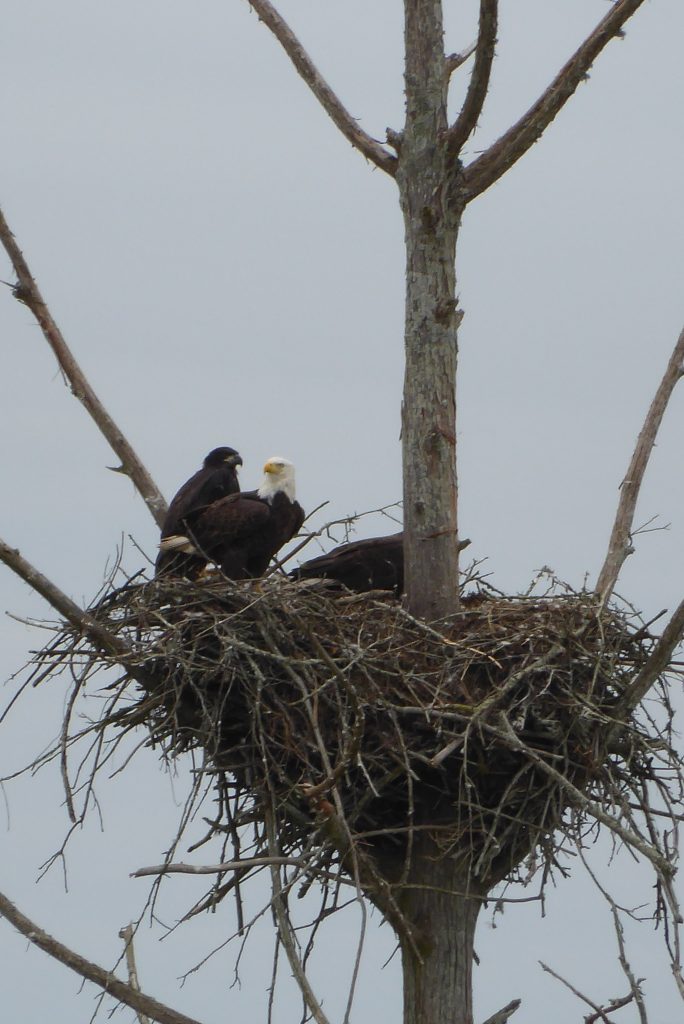
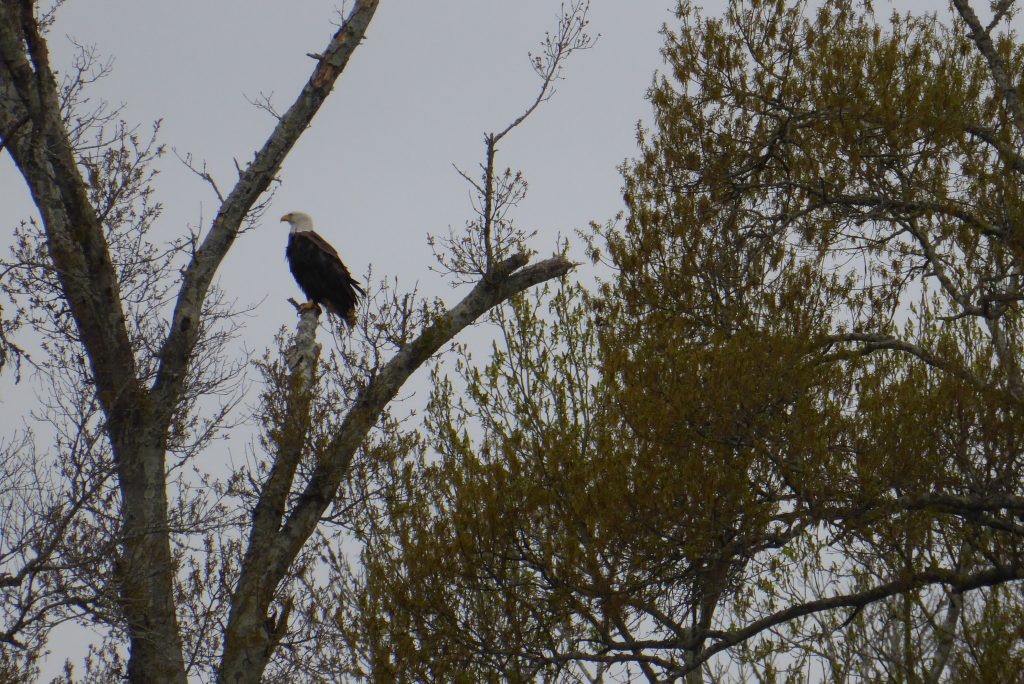
As we rode up to get a better view, another of the magnificent birds, once threatened with extinction in the US flew above our heads to a tree by the roadside and took up watch. Two adults and a chick, just amazing and a real highlight of the ride so far. On the wildlife side, it’s definitely getting more exotic here if the roadkill is anything to go by … raccoons, armadillos, turtles, alligators and even beavers. Hopefully the roadkill numbers reflected the abundance of live animals!

A quick loop which took us round onto the banks of the Raccourci Old River revealed just how high the waters were – several properties were underwater with only their roofs visible. It looked like you’d need a boat to get to the local restaurant and dress for dinner would probably involve swimming trunks and a snorkel.

Today was beginning to feel like a proper trail day … small roads, varied scenery, a tailwinds and other people. As we were leaving the loop to rejoin the main road we spotted John from Boston who had started in Georgia and was heading to San Diego. Apart from Ben and Thomas, who we’d seen on day three and Jules and Harvey who we’d met at Biloxi, we’d seen virtually no other cyclists attempting the Southern Tier. John was using the maps, but also taking diversions. He appeared to have had an even more horrific and terrifying experience than us. He seemed relieved to find someone else who agreed with his bleak assessment of the ride so far.
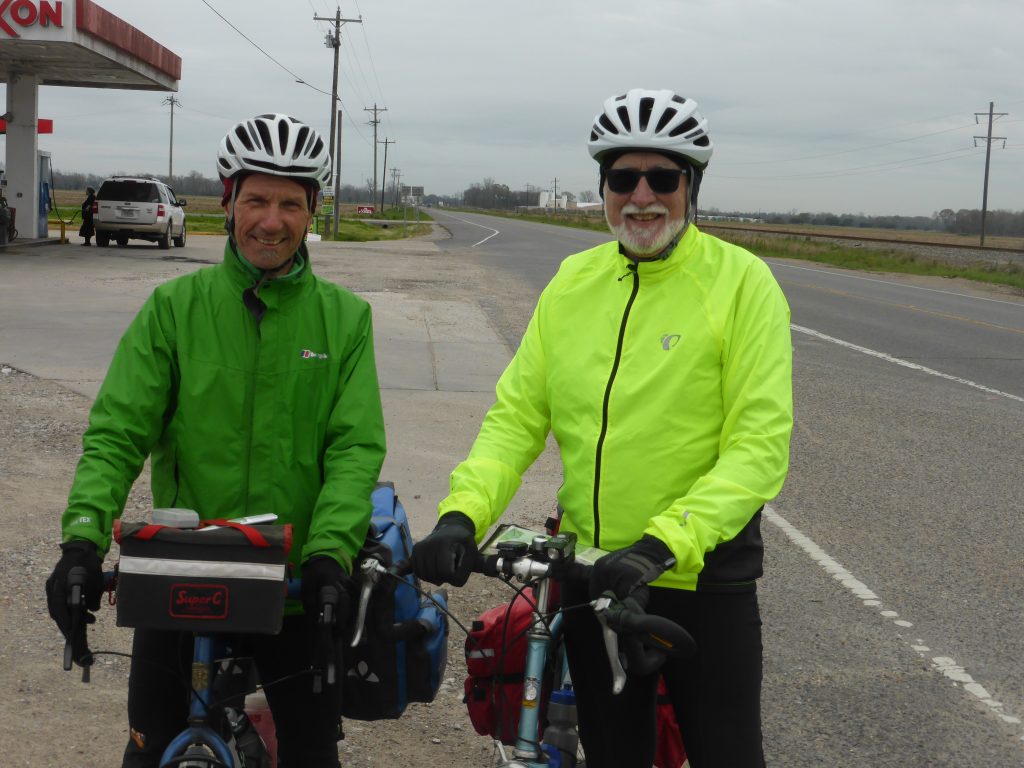
“You are the first touring cyclists I’ve seen,” he said. “There have been some horrible roads with no shoulder and trucks honking their horns and shouting at me. I thought it was just me going through this.”
Rather than follow the official route that day he was heading west as fast as possible – he had a hotel booked 40 miles away and said there were reports of tornados possibly coming in. “I’m not camping,” he said, which explained why he only needed two panniers. “I’m staying in hotels – I’m retired and spending the inheritance.”
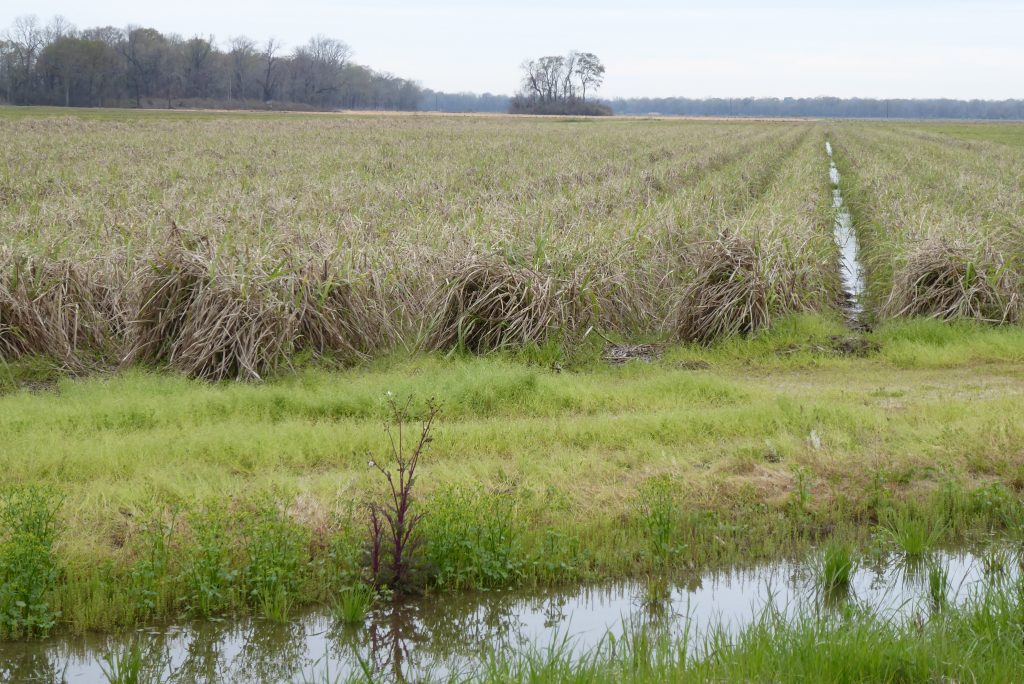
We swopped contact numbers – there is a possibly we might see him further on – and headed off. “This is it!” I kept saying to Terry, convinced the horrors of the 90 through Florida and the delights of various Scenic Highways were now long gone.
“This really is beginning to feel like the sort of ride we had in the TransAm – quiet roads, lots of interesting things to see. This must be it – the Southern Tier has finally started!” I continued. Terry was less convinced, but I felt he was warming to the ride – and soon something happened that really confirmed it – someone let the dogs out.
“I’m still impressed with my own power of acceleration when required,” said Terry. What he really meant was: “I can still outrun Paul anyday and that’s all that matters”.
We were chased today by more dogs than all the previous days combined – and Louisiana dogs are smart. One pair idly ambled alongside us, friendly as anything, and then took up the chase just as we has been lulled into a false sense of security. Another slunk in the grass like a cat and then ambushed us from the side. But I’ll take being chased by a dog over a day spent on the 90 any day. A dog can only bite you – with a truck it’s game over. Besides, trying to outrun them on the bike was fun, although I’m still not convinced my new dog dazer, which zaps them with high pitched electronics, is working.
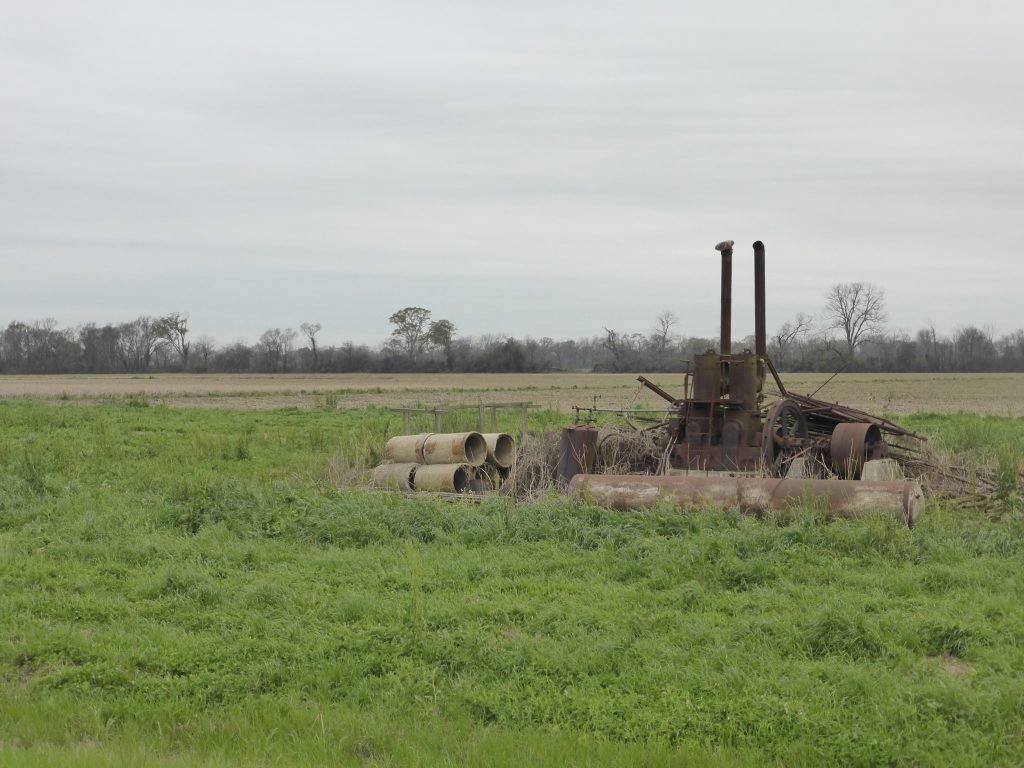
There were frequent shouts of ‘incoming!’ as the next pack of hounds belted across their land to greet us with a snarl. “I’m still impressed with my own power of acceleration when required,” said Terry, although what he really meant was: “I can still outrun Paul anyday and that’s all that matters”.
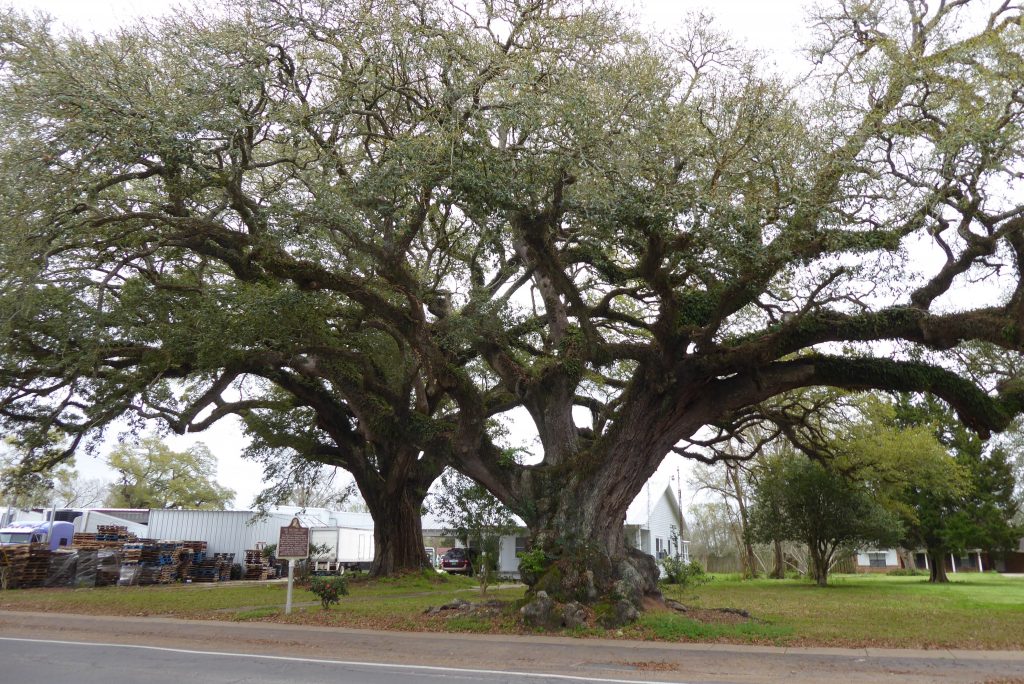
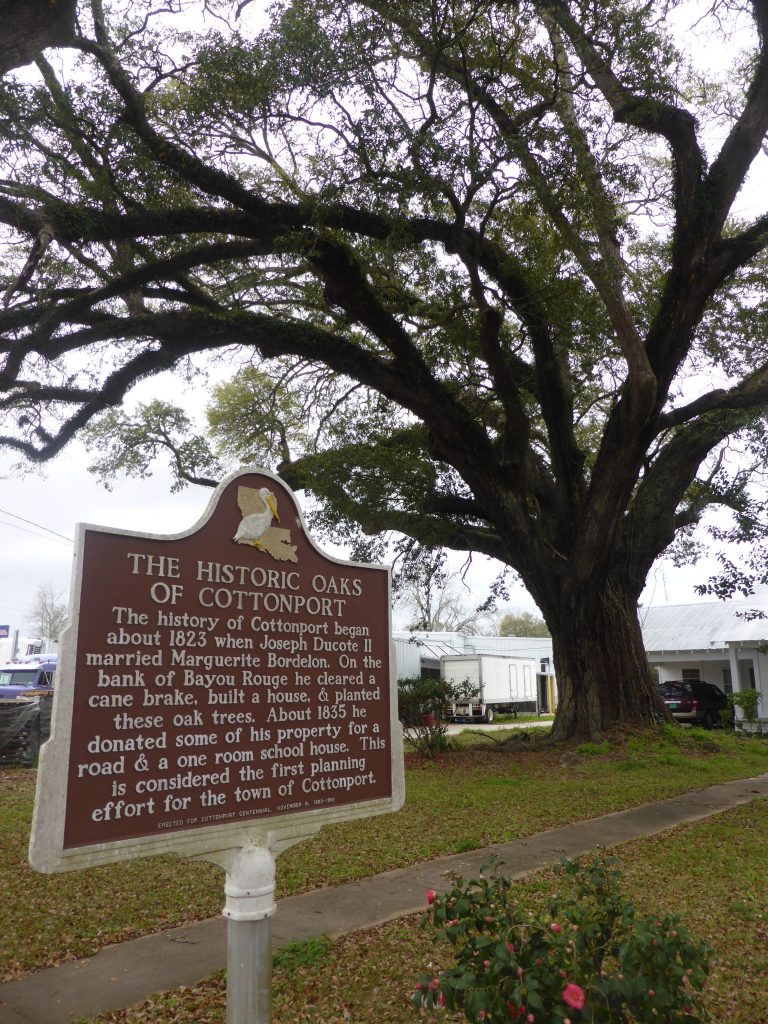
We stopped for lunch at Maddies Truck Plaza in Simmesport, which also offers camping for bikers, gazed in awe in Cottonwood at two massive live oak trees planted in 1823 and grimaced as the last five miles turned out to be into the wind on a poor road surface.
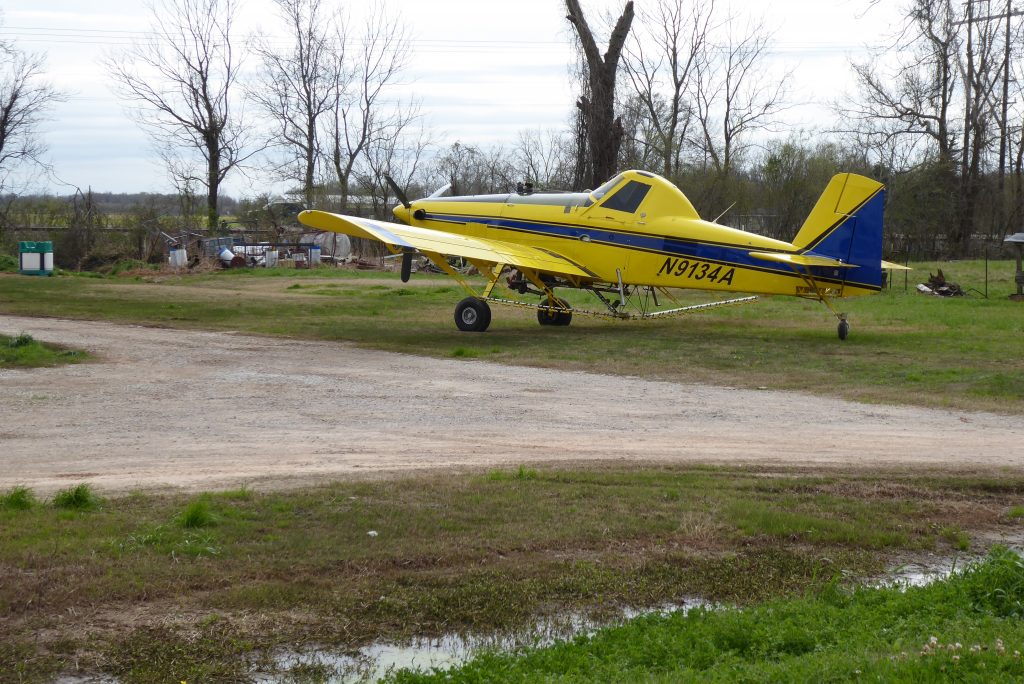
Pulling into Bunkie we decamped to the Pizza Hut where, ravenously hungry, we both ordered far too much. Terry was instantly tetchy as there was no salad bar and I had to apologise to the waitress as we bickered like an old married couple. Never let a vegetarian build up a lust for fresh leaves then deny him. My pepperoni with extra pepperoni and soaked in cheese was a mistake and even I couldn’t finish it. We left feeling bloated and set off for Dollar General to get some much needed bran for breakfast.
“She set off at a pace even Chris Froome would have struggled to keep pace with, let alone bikes laden down with five panniers”.
Turning to head to the fire station, where we planned to stay for the night, a red convertible beetle drew up alongside us and out popped a woman who introduced herself as Caroline – all energy and smiles. “Hi!” she beamed, following up with “Are you lost? You’re trying to find the fire station aren’t you? They are expecting you.”
She told us her son was a keen cyclist so she was always happy to help out those with the same interest. “Follow me!” she said, jumped back in, switched on her hazards and she set off at a pace even Chris Froome would have struggled to keep pace with, let alone bikes laden down with five panniers.
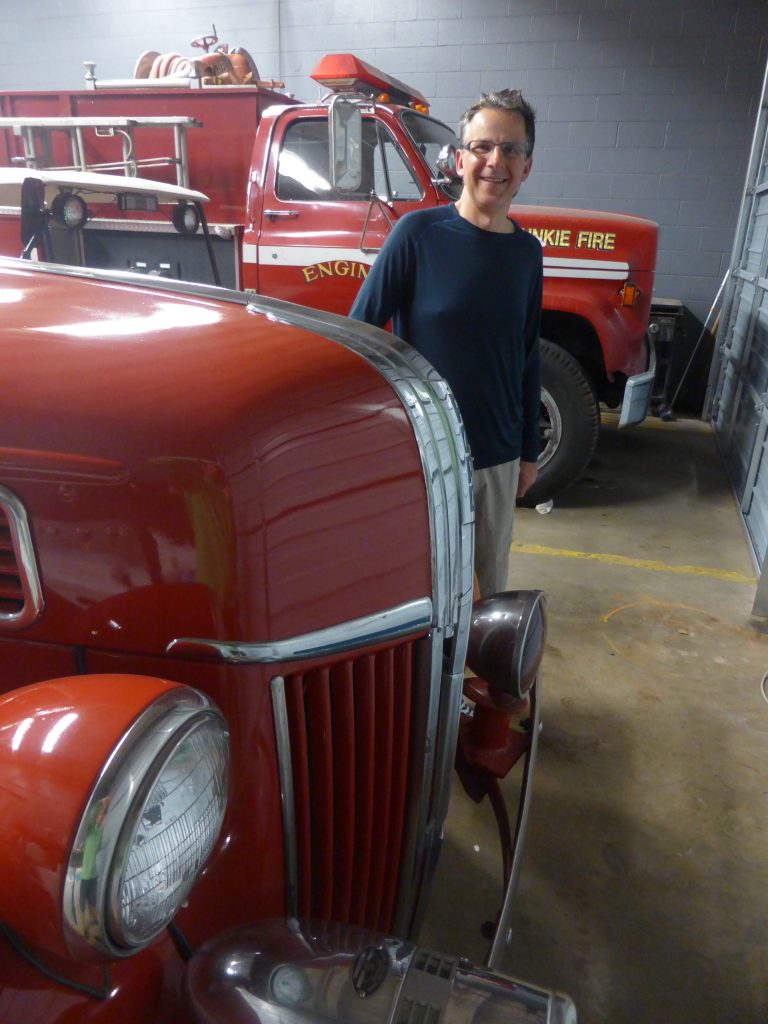
We arrived at the Bunkie Fire red faced and gasping and were introduced to full time members of the crew and some of the volunteers fire-fighters. When I’d rung the day before to check we could stay there the fire officer had said there was only one condition – we had to have a shower.
When I’d explained what he’d said to Terry his only comment was: “Wow – they could smell you down the phone?” Ashton gave us a whistle stop tour, including a look at an original fire engine from the 1940s, now used in parades, demonstrated how to use the showers (yes we did take one, although it seemed some of their previous visitors had refused – hence the ruling) and told us to make ourselves at home.

The crew explained the majority of their jobs are to medical calls. Unlike in the UK, it’s the fire service which are the first responders to any incident and are able to give first aid. If an ambulance is required the 911 call is then routed through to the local ambulance provider and the caller has to go through all the details again.
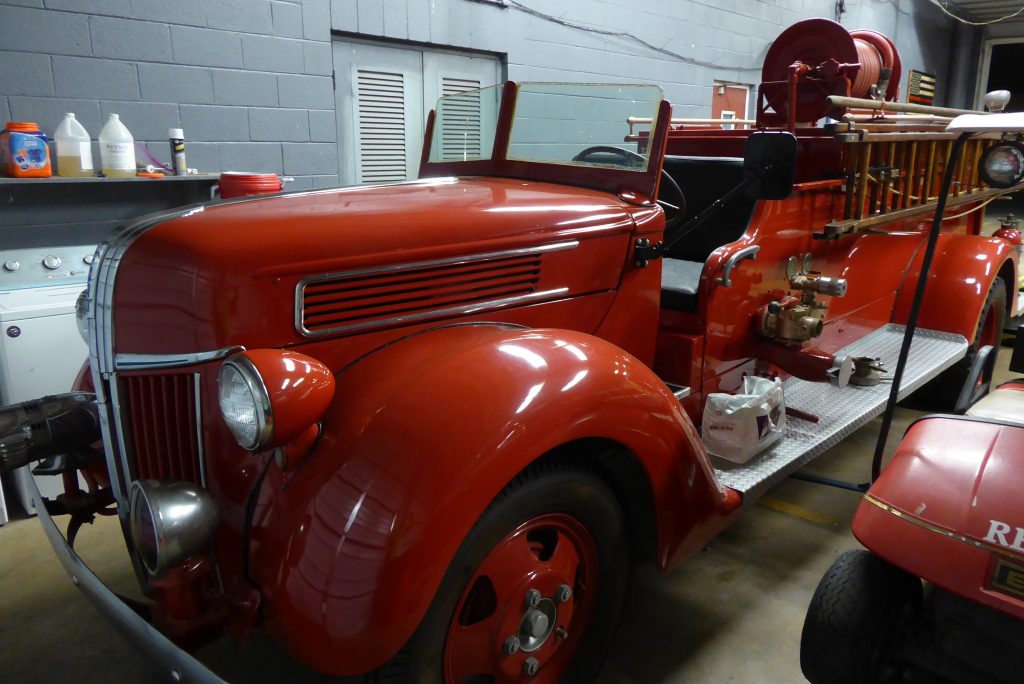
“Often we get there and the caller is still on the phone to the ambulance,” said Geoffrey, one of the full-time staff, who said it was a problem with the current system. It seemed an unnecessary delay in what was a time critical situation and made us appreciate, not for the first time, the free service provided by the NHS.

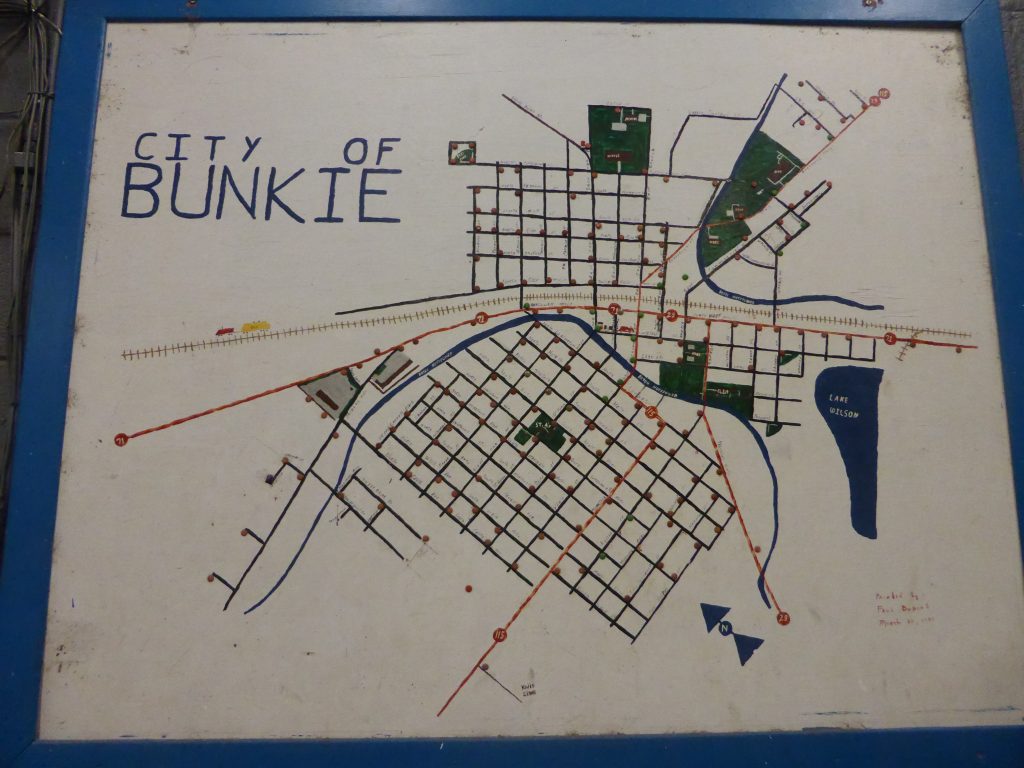
The fire-fighters spoke with a rich slurred drawl, laced with plenty of y’all’s and ma daddies and it took quite a time to tune into what they were saying. But eventually the ear and brain adapts and we were able to make out a conversation which mainly centred around fishing, trucks, food and TV. The same conversation, with a few tweaks, was probably going on between men the world over – only the language was different.
Fully refreshed we crashed out on the sofas and didn’t wake up until just before seven the next morning, just as the shift was changing.
Today’s mileage: 65.01
Total miles since Anastasia State Park: 868.48

